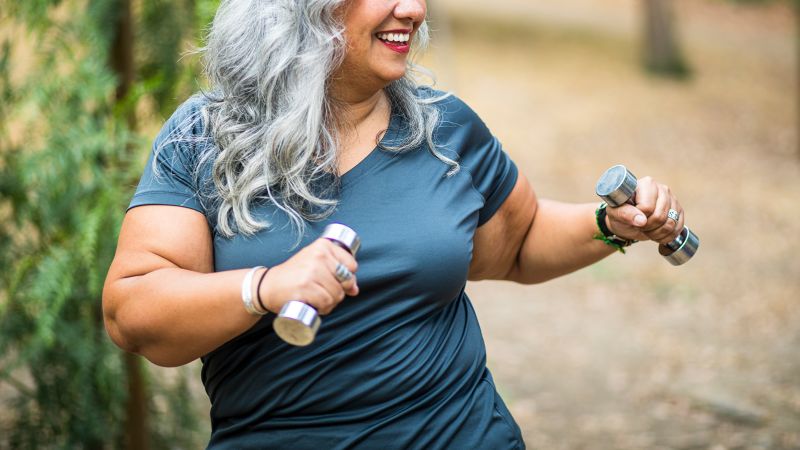Editor’s note: Before starting any new exercise program, consult your doctor. Stop immediately if you feel pain.
CNN
—
People often lament gray hair and wrinkled skin among the most unpleasant side effects of aging. It can be disheartening to see your young face disappear, but the state of your strength, balance and flexibility is of much greater concern. Significant declines in these areas can lead to pain, falls, and fractures, as well as an overall loss of mobility and functionality. Think of the inability to play with grandchildren, climb stairs or carry groceries.
No matter how active we are, our muscle mass and strength decline with age. In fact, muscle mass and strength peak between the ages of 30 and 35. After that, they slowly but surely decline. At age 65 for women and age 70 for men, the pace of these declines accelerates, according to the National Institutes of Health. Likewise, everyone’s balance and flexibility decline with age due to changes in vision, sensory nerves, joints, ligaments and more.
“Joints in the spine, hips, knees, and shoulders naturally become more arthritic as we age, and our ligaments and the interfaces between our tendons and muscles become stiffer,” said Dr. George Eldayrie, sports medicine physician at Orlando Health Jewett Orthopedic Institute in Winter Garden, Florida. “It’s a very well-known process.”
Because these declines are well documented, The United States Centers for Disease Control and Prevention recommends adults age 65 and older engage in moderate-intensity exercise for at least 150 minutes per week. Also, they should perform strength and balance exercises at least twice a week.
Sneksy/E+/Getty Images
Adults 65 and older should perform strength and balance exercises at least twice a week.
How to improve the quality and quantity of your life
Strength, balance and flexibility are all important, but is it more important to improve one than another? In general, if you’re looking to improve the quality and quantity of your life, getting aerobic exercise should be your top concern, said Dr. John Higgins, sports cardiologist at the University of Texas McGovern Medical School. Health Sciences Center in Houston. Resistance training comes next in importance, with a mix of balance and flexibility work coming in third.
At the individual level, however, it all depends on the patient, Eldayrie said. “For a top athlete, strength and flexibility are probably more important to help performance and reduce injury,” he said. “Someone who is 85 and wants to be functional, however, will focus on balance and strength to help reduce their risk of falling.”
There will also be differences depending on a person’s health. Someone with arthritis should focus on joint flexibility first, Eldayrie said, while someone who just had knee replacement surgery should focus on strength training. If you have osteoporosis, it’s important to work on your balance to avoid falls.
READ MORE: Sign up for CNN’s Fitness, But Better newsletter series. Our seven-part guide will help you get into a healthy routine, backed by experts.
Despite evidence of the importance of physical activity, 28% of Americans 50 and older are inactive, according to a 2016 CDC study. Moreover, inactivity increases with age, with more than 35% of people aged 75 and over being inactive. It is a problem. Physical activity can improve mental health and prevent dementia and cognitive decline. Add to that the benefits of strength, balance, and flexibility, and you have a great chance of aging well.
adamkaz/E+/Getty Images
Combining strength training with weights and aerobic exercise is a great way for seniors to keep moving.
“Think of it as a pyramid,” Higgins said. “Aerobic exercise is the top of the pyramid, the bricks that hold it up being strength, balance and flexibility. Without those foundations, the pyramid will crumble. You can’t do any of these things on your own.
If the thought of incorporating aerobic, strength, balance, and flexibility exercises into your weekly routine seems overwhelming, keep in mind that you don’t necessarily need a gym membership or a personal trainer. This important work can be woven into your life quite seamlessly.
For example, golfing and gardening are enjoyable ways to add aerobic exercise to your life. The same goes for walking the dog. Strap on a weighted backpack on your walk, and now you’re doing ‘rucking’, an exercise based on military training that combines aerobic exercise with strength training. Yoga is a gentle activity on the body that helps with flexibility, but it also builds strength and activates your core. Standing on one foot in line or in front of the TV is an easy way to add some balance training to your life.
“A lot of people like to complicate things by having a plan and measuring their progress, but it doesn’t have to be so complicated,” Eldayrie said. “Just incorporate these things into your daily life and be consistent. The benefits will come over time. »
Higgins agreed. “If you don’t think strength, balance and flexibility training will really help, try it for a few months and see what a difference it makes,” he said. “You’ll likely find that you enjoy things more and are able to do regular aerobic work more easily and with less injury, whether that’s playing with the grandkids or doing an exciting activity like zip-lining.”
Melanie Radzicki McManus is a freelance writer specializing in hiking, travel, and fitness.
